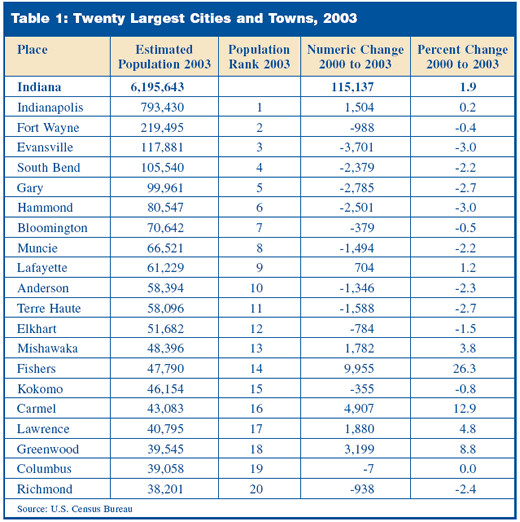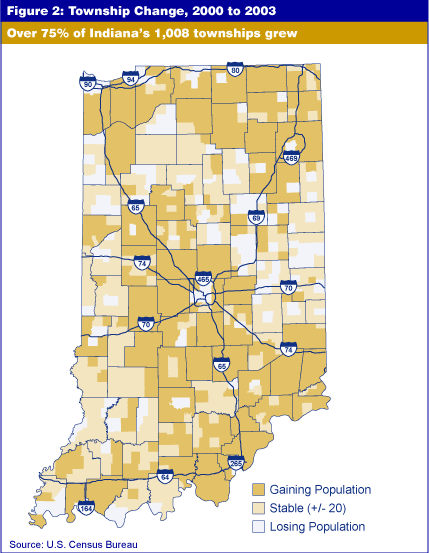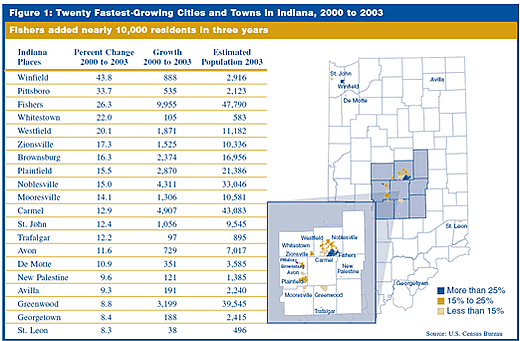Who's Growing and Who's Not? City and Town Population in 2003
New data show that Indianapolis has maintained its rank as the 12th largest city in the United States every year since the 2000 Census. However, by this time next year, the Circle City will probably give up that spot to 13th-ranked Jacksonville, Florida, which is the third fastest-growing of the nation’s 25 largest cities.
Each summer, the U.S. Census Bureau releases official population estimates for the nation’s counties, cities, towns and other subcounty units. The most recent figures represent the Bureau’s best guess as to populations on July 1, 2003. Unlike the major census that actually counts people every 10 years, these annual updates use administrative records to estimate population changes since the 2000 census.
This procedure pegs the growth of Indianapolis at only 0.2 percent from 2000 to 2003, while Jacksonville grew by an impressive 5.2 percent. Most of the fastest-growing cities of the nation are located in the Sun Belt states of the South and West; however, two Illinois cities made the 25-fastest-growing list: Peoria (17.4 percent) and Aurora (13.3 percent).
Shifting the focus closer to home, Census estimates reveal a mixed picture of population growth and shrinkage throughout Indiana. Of the state’s 569 incorporated cities and towns, 219 grew in population, with estimated growth ranging from one person in several places to nearly 10,000 people in the booming town of Fishers (no, it’s not a city!).(1) Population gains for all 219 growing cities and towns totaled 181,117 people. It is important to note that the population changes described here are based on a Census 2000 figure adjusted to reflect boundary changes submitted to the Census Bureau through January 2003.
Figure 1 presents the changes in Indiana’s 20 fastest-growing cities and towns. Seven of these fast-growing places are small towns with fewer than 5,000 residents, where a modest change can represent a relatively large percentage of the total population. But nine of the fastest-growing cities and towns have more than 10,000 residents. And, as shown in Figure 1, 14 of these fast-track places are located in the Indianapolis metropolitan area.
Population changes in Indiana’s largest cities have varied greatly since the 2000 Census, as displayed in Table 1. Only seven of the 20 largest cities grew at all during this period. The rest of the large cities experienced population losses ranging from seven people in Columbus to 3,701 in Evansville. Altogether, population declines were experienced by 321 of Indiana’s 569 cities and towns. These losses totaled 36,295.

So, if shrinking towns and cities significantly outnumber growing ones, is Indiana losing people? Far from it: the state’s population grew by an estimated 115,137 people between April 1, 2000, and July 1, 2003. On average, cities and towns with increasing populations grew by significantly larger amounts than declining places shrank.
A closer analysis of where the population has increased and decreased examines changes for all of Indiana’s 1,008 townships. More than three-fourths of the state’s townships grew during the first three years of the decade, as evident in Figure 2.

All but one of the 10 townships showing the largest estimated population gains are in the counties surrounding Indianapolis. This reflects a trend in which population is shifting from many of the state’s larger cities to the surrounding towns and unincorporated areas. The trend is also evident in the townships with the largest decreases in population. The two biggest losers are at the old, industrialized northern end of Lake County, while St. John township, farther south in Lake County, is the seventh fastest-growing township in the state.
Population estimates for all Indiana counties, cities, towns and townships are available online at www.stats.indiana.edu – click on Population under Data Tables.
Notes
-
A Special Census conducted for the Town of Fishers yielded a population or 52,390 as of November 2003. Special Censuses are actual head counts, not the results of estimation formulas. Thus, Fishers is growing faster than current estimates reveal. This special census will be taken into account when the 2004 estimates are released next year.
Jerry Conover
Director, Indiana Business Research Center,
Kelley School of Business, Indiana University

